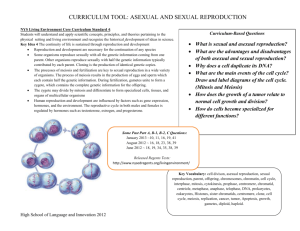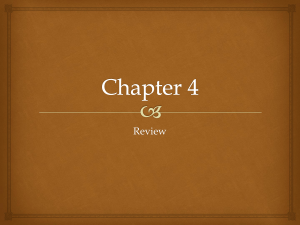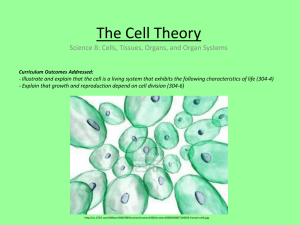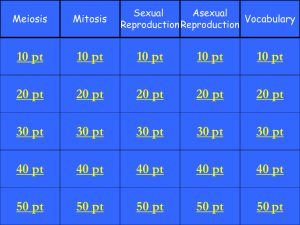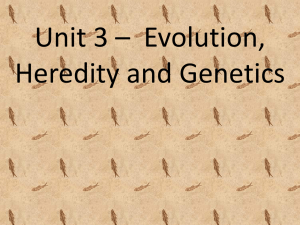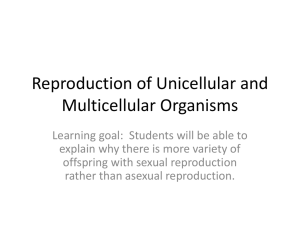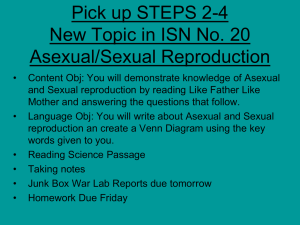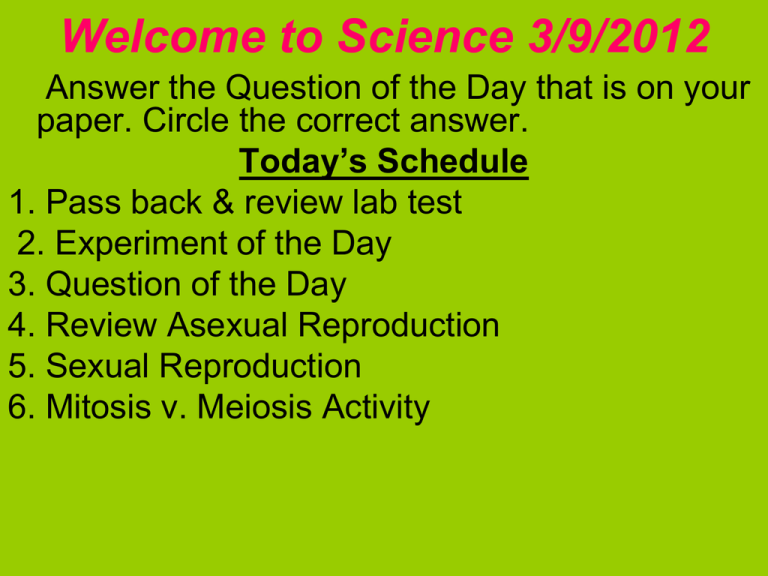
Welcome to Science 3/9/2012
Answer the Question of the Day that is on your
paper. Circle the correct answer.
Today’s Schedule
1. Pass back & review lab test
2. Experiment of the Day
3. Question of the Day
4. Review Asexual Reproduction
5. Sexual Reproduction
6. Mitosis v. Meiosis Activity
Question of the Day
• Hunter found some termites in a wooden board sitting
in his backyard, so he sprayed some insecticide on
the board to kill the termites. Hunter noticed that about
95% of the termites died, but 5% survived. What is the
most likely explanation for this?
A. The living termites had genes that the dead termites
did not have.
B. The living termites knew that Hunter was going to
spray the insecticide, so they camouflaged
themselves.
C. The living termites were a different species than the
dead termites.
D. The living termites were males and the dead termites
were females.
Asexual Reproduction Review
• What is asexual reproduction?
• One parent produces two new, genetically
identical organisms.
Asexual Reproduction Review
• What are some organisms that can reproduce
asexually?
• Plants, simple organisms, and some complex
organisms.
Asexual Reproduction Review
• What are the types of asexual reproduction?
• Binary fission, budding, regeneration, and
parthenogenesis
The Big Picture
• Asexual reproduction limits the spread of
different characteristics through a species
and only allows for genetic continuity.
• This can be good or bad for the organism.
It all depends on the environment.
• Sit with your lab group and get out your sexual
reproduction notes that we began on Friday.
• Today’s Schedule
• 1. Schedule for the week
• 2. Question of the Day
• 3. Review Sexual Reproduction
• 4.. Mitosis v. Meiosis Lab
Question of the Day
• Both paramecia and fish live in a shallow pond. The
paramecia usually reproduce asexually. The fish
reproduce sexually. Suppose the environmental
conditions in the lagoon change. What advantage will
the sexually reproducing fish have?
• A. sexual reproduction decreases the genetic
variability in the fish populations.
• B. Sexually reproducing fish produce offspring that are
identical to the parents.
• C. Sexual reproduction limits the spread of harmful
characteristics in fish populations.
• D. Sexual reproduction in fish allows populations to
adapt to new conditions over fewer generations.
Video of the Day
Video -- Bighorn Sheep Competition -- National Geographic
Sexual Reproduction
• How is sexual reproduction different than
asexual reproduction?
• Sexual reproduction produces a new organism
when sex cells from two parents combine to
make a new organism.
Production of Cells
• A human body cell has 46 total chromosomes.
• Chromosomes- parts of a cell that store the
hereditary information that is passed on
How do we get new cells?
• Cells are alive. Therefore, cells have a life cycle
• Mitosis (cell division)- process by which a cell
nucleus divides to form two identical cells
• Animation: Mitosis
How do organisms produce sex cells?
• Remember, a human body cell has 46 total
chromosomes.
• How many chromosomes would there be when two
human sex cells combine?
•
List of organisms by chromosome count
Human sex cells can only have
23 total chromosomes.
How do we produce sex cells?
• Meiosis- the process of cellular division that
produces sex cells.
• Meiosis happens in the reproductive organs of
plants and animals. Meiosis: An Interactive Animation
• Animation: How Meiosis Works
Meiosis v. Mitosis
Fertilization
• S.R. starts with the formation of sex cells and
ends when one sex cell joins another and a
new organism is begun.
• Fertilization- the joining of an egg and sperm
The Big Picture
• Sexual Reproduction involves two organisms.
• Each parent organism passes their traits on to
the offspring.
• The offspring is born with a combination of traits
from its parent.
• This combination of traits will either increase or
decrease the offspring's chances of survival.
Mitosis v. Meiosis Lab
• 1. On the back of your notes you are going to
create models of the process of mitosis and
meiosis.
• 2. First, use your text book to create a sketch of
mitosis and meiosis in the correct locations of
your paper.
• 3. Second, you will create a 3-D model of
mitosis and meiosis using clay.
• 4. In your model, include all of the important
details of the cells.
Mitosis v. Meiosis Lab
• Everyone will fill in the lab sheet, help in
creating the models, and answer the questions.
• After finishing the lab sheet create a model of
all of the following:
• A hydra budding
• A Sea star regenerating a arm
• A bacteria undergoing binary fission

